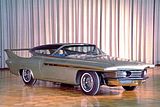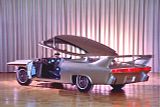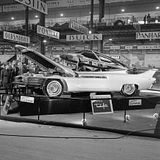Concept cars are supposed to be the stuff of dreams, and few cars exemplified this better than the 1961 Chrysler Turboflite, a joint venture between Chrysler and Italian design firm Ghia. Giving a nod to America’s fascination with space flight, the Turboflite looked every bit the part of a road-going rocketship, and even its gas turbine engine spoke of a future where piston engines would be reserved for appliances like lawn mowers and snow blowers. Though the future predicted by the Turboflite concept never quite materialized, the car did cast a shadow of influence on the industry that extended well beyond Chrysler’s product line. Like the GM Firebird concepts of the 1950s, the Chrysler Turboflite borrowed many styling cues from aircraft design. Its frontal area was reduced to cut drag, and to improve airflow even further, the outboard headlamps tucked underneath the leading edge of the fenders when not in use. Instead of a conventional roof, the Turboflite featured a canopy that automatically tilted upward when the recessed door handle was pressed. In conjunction with conventional doors, the canopy allowed for easy entry and exit from the Turboflite’s four-passenger interior, although the design eliminated any possibility of using conventional windows. Instead, the Turboflite’s broad side windows opened outward on roof-mounted hinges to allow additional ventilation (though likely not at speed). At the rear, a pair of vertical stabilizers rose from the tops of the fenders to form a basket-handle wing, not dissimilar from the one that would later appear on Dodge Daytonas and Plymouth Superbirds built for NASCAR competition. Unlike the later products from Chrysler, the wing on the Turboflite wasn’t there to add downforce to the rear wheels for cornering; instead, it served as an air brake, helping the Turboflite driver scrub off speed quickly by dramatically increasing drag. Activated automatically when the driver applied the brakes, the air brake could be disabled for city driving at (presumably) lower speeds. The air brake was more than just a gimmick. Turbine engines, such as the third-generation CR2A used in the Turboflite, provided virtually no compression braking when the throttle was released. Instead, all reduction in forward motion essentially came from the car’s hydraulic brakes, so the air brake was seen as a necessary addition to reduce brake fade on repeated high-speed stops. The Turboflite’s rear vertical fins also contained eye-level brake lights that utilized a bright bulb for enhanced daytime visibility, coupled with a dimmer light for nighttime driving. While high-mounted stop lamps became mandated by the Department of Transportation in 1986, another of the Turboflite’s innovative safety systems never caught on: When the driver lifted off the accelerator, an amber light would illuminate on the car’s full-width taillamp panel, advising trailing drivers of a pending change in momentum. The full-width taillamp design would later appear, in modified form, on the 1966 Dodge Charger. The CR2A engine chosen for use in the Turboflite concept was vastly improved from earlier turbine engine versions, thanks to its innovative variable turbine nozzle design. This reduced the time required for the turbine to spool up to full operating speed from seven seconds (on Chrysler’s original CR1 turbine) to just one and a half seconds, producing acceleration that was nearly akin to a conventional piston engine. The variable turbine nozzle helped reduce fuel consumption as well, and in a coast-to-coast test of the engine (in a 1962 Dodge Dart Turbo prototype), Chrysler claimed that the CR2A returned better fuel economy than the piston-engined support vehicle. Others testing later turbine cars would dispute this claim, reporting fuel economy that in some cases barely topped 10 miles per gallon. High exhaust gas temperatures were another issue, though it’s likely that the automaker could have developed ways to mitigate this. Inside, the Turboflite was equally impressive, boasting futuristic seating (trimmed in brushed aluminum) and electroluminescent lighting in door panels and instrumentation. While some gauges (such as the tachometer and speedometer) were conventional, the aircraft-style panel also included a pyrometer for measuring intake exhaust gas temperatures. Controls were, for the most part, conventional, but accelerator and brake pedals were deliberately oversize; with no dead pedal and limited space in the footwell, a driver had no choice but to rest both feet on the pedals, an odd design that Chrysler insisted would help reduce reaction time by forcing a driver to brake with his left foot. The Turboflite lacked a conventional horn switch as well; instead, a driver gripped the inside of the steering wheel to sound the horn, an idea that never found broad acceptance. The Turboflite proved to be a sensation on the show circuit, but the striking concept car never reached production. Chrysler did continue to develop the turbine engine for use in passenger cars, but even this eventually proved fruitless, as the engine’s drawbacks ultimately outweighed its benefits. Designs used in the Turboflite (such as its oversize rear wing/air brake) would ultimately surface on other Chrysler products, and concepts like eye level brake lights would ultimately find their way into production across the entire industry. Even the idea of a high-speed airbrake has resurfaced on modern cars such has the Bugatti Veyron, so perhaps the Turboflite envisioned more of the future than it’s credited for.
Hemmings Daily Kurt Ernst Feb 13th, 2014 |
|






